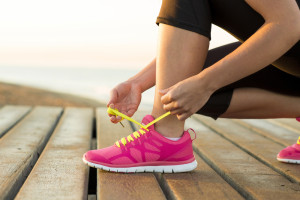 Foot injuries can happen easily and will cause you a lot of pain and, in some cases, doctor visits. A common reason people injure their feet is due to improper shoe choices for the activity they are participating in. Choosing the right shoe for an activity is important. Here is a list of 10 shoes that can help keep your feet safe while doing outdoor activities.
Foot injuries can happen easily and will cause you a lot of pain and, in some cases, doctor visits. A common reason people injure their feet is due to improper shoe choices for the activity they are participating in. Choosing the right shoe for an activity is important. Here is a list of 10 shoes that can help keep your feet safe while doing outdoor activities.
1. Running Shoes
Running is a popular exercise and improper shoes can lead to sometimes severe injuries that can keep you off your feet for weeks, such as shin splints, heel pain and tendinitis. Good running shoes should have enough cushioning to absorb shock and good heel control. Running shoes are lightweight and are low-cut to allow your foot to be flexible.
2. Walking Shoes
Walking shoes and running shoes offer different options: Where running shoes offer cushioning at the heel, walking shoes have additional cushioning under the ball of the foot. Walking shoes also are not as breathable or lightweight as running shoes. These types of shoes are also more rigid in the front than other types of shoes, so that you can roll off your toes rather than bend them.
3. Basketball Shoes
Good basketball shoes offer great ankle support and will have a thick, stiff sole to allow more stability while you are on the court. Most basketball shoes are high tops, which allow even more stability than the low cut versions.
4. Cross Trainers
Cross trainers are the go-to shoes if you are going to participate in a variety of different sports or activities. Good cross trainers offer great flexibility with good foot control. If you play a lot of different sports, such as tennis and basketball, cross trainers are a solid choice of shoes.
5. Hiking Boots
Choosing the right hiking boot is important if you are planning a long trip. Good hiking boots will offer you comfort, stability, thick soles and good grip to deal with whatever environment nature throws at you. You won’t want to bring your running shoes or cross trainers on a hiking trip. They may be lightweight and comfy, but they won’t offer you the support or protection a hiking boot will while negotiating difficult terrain.
6. Tennis Shoes
People that play tennis need shoes that support their feet during quick movements. Tennis shoes offer stability for the inside and outside of the foot and they are flexible in the sole beneath the ball of the foot to allow for quick movements. Tennis shoes tend to have less cushioning since the shock absorption isn’t needed.
7. Aerobic Shoes
Aerobic shoes are lightweight to prevent foot fatigue and have extra shock absorption in the sole beneath the ball of the foot, where most of the stress occurs during a workout.
8. Casual Shoes
When choosing a new pair of casual shoes, make sure they have proper arch support and fit correctly, with enough room in the front to wiggle your toes and are comfortable. Casual shoes tend to be light weight and come in a variety of styles, with variations on cushioning and design.
9. Dress Shoes
Dress shoes don’t allow for flexibility and usually offer poor arch support. Dress shoes are often uncomfortable and its advised not to wear them for prolonged periods to avoid foot pain.
10. Cleats
If you are an avid football, baseball or soccer player, cleats are the shoes you need. They offer extra foot support and shock absorption and have better grip on the grass than other shoe types.


